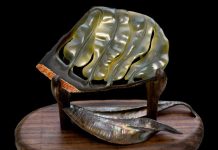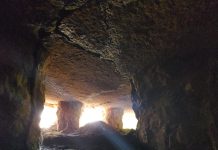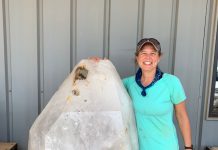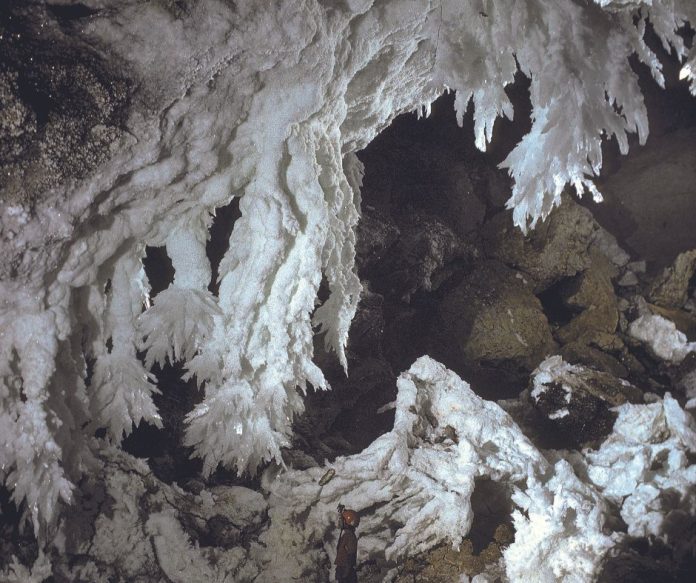
Gypsum [hydrous calcium sulfate, CaSO 4·2H 0] is the most abundant of the 150 sulfate minerals. It crystallizes in the monoclinic system as prisms and flat blades, and also occurs in massive and fibrous forms. It has a low density (specific gravity only 2.3), a vitreous luster, and perfect, one-directional cleavage. Gypsum has a Mohs hardness of just 2.0, far too soft for gemstone use and its thin crystals are flexible.
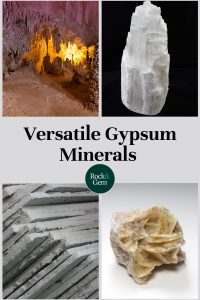
Moderately soluble in water, gypsum exhibits the unusual property of retrograde solubility, meaning that its solubility decreases as temperatures increase. Gypsum emits or “evolves” heat upon dissolution, rather than absorbing it like most minerals. As solvent temperatures increase, gypsum molecules evolve heat at a greater rate to reduce the kinetic energy needed to disassociate, thus decreasing its solubility.
An Image Problem
Gypsum has always had something of an image problem. Not being a gemstone or ranking in the top tier of collectibles, it lacks the glamour associated with certain other minerals. Gypsum is sometimes even dismissed as just another industrial commodity. But don’t sell gypsum short! The selenite variety of gypsum is eye-catching and its crystals are some of the largest ever found. Gypsum’s alabaster variety has been prized as a sculpting medium since antiquity, while its lustrous satin-spar variety glows with mesmerizing chatoyancy. Gypsum forms stalactites and other intriguing cave features, while a huge expanse of gleaming white dunes of pure gypsum sand is the main attraction at New Mexico’s White Sands National Park.
Few other minerals can match gypsum’s 8,000-year-long history. Gypsum is also the basis of multibillion-dollar-per-year mining and manufacturing industries.
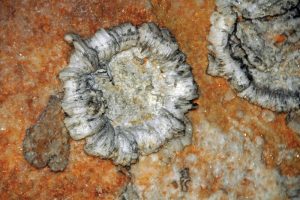
Gypsum is widely distributed and occurs in many mineralogical environments, most commonly in massive beds of lithified marine evaporites within shale, sandstone, and limestone formations. Gypsum also forms by precipitation at hot springs, condensation of volcanic vapors, and the reaction of calcite [calcium carbonate, CaCO 3 ] with sulfuric acid resulting from pyrite oxidation. It is a component of most soils and clays.
Selenite
Gypsum’s transparent-to-translucent, crystalline variety is selenite, a name derived from the Greek selenites, meaning “stone of the moon” and alluding to the soft, white, moon-like luster of its crystal faces. Selenite occurs in tabular, prismatic, and acicular habits.
Selenite sceptors a foot or more in length, are often seen in rock shops and at gem and mineral shows. Collectors also prize unusual gypsum forms like spiraled “ram’s horns” and “fishtail” or “swallowtail” twins.
Pure gypsum is colorless or white, but impurities impart a range of pale colors. Iron creates yellows and browns, while copper produces blues and greens. Some green selenite contains inclusions of herbertsmithite [hydrous copper-zinc chloride, Cu 3 Zn(OH) 6 Cl 2 ]; inclusions of hematite [iron oxide, Fe 2 O 3 ] or botryogen [hydrous magnesium iron sulfate, MgFe(SO 4 ) 2 (OH)·7H 2 O] create reddish hues.
Huge Crystals
Under certain conditions, selenite crystals can grow to an extraordinary size. In 1999, geologists exploring the inactive Pilar de Jaravía lead mine in Spain’s Almería Province found the Pulpi Geode, a natural underground void filled with hundreds of colorless, transparent, perfectly formed selenite crystals, some as long as six feet.
In 2000, miners at the Naica lead-silver-zinc mine in Chihuahua, Mexico, discovered a huge underground chamber filled with enormous, translucent, white selenite crystals. The largest was 37-feet-long and weighed an estimated 55 tons.
Alabaster
Gypsum also occurs as dense, fine-grained, massive alabaster in veins of variable thickness and is sometimes called “poor man’s marble.” Alabaster colors can be uniform or mottled and range from snowy white and gray to soft pinks, yellows, and browns. Soft and easily carved, it takes a fine polish. Its slight translucency imparts a subtle, warm glow similar to that of fine marble. Alabaster has served as a sculpting medium for more than 5,000 years.
The general term alabaster also refers to a calcite type known as travertine. While archeologists and sculptors use the word alabaster for both the gypsum and calcite types, geologists use the word specifically for gypsum alabaster.
Satin Spar
Satin spar, the fibrous variety of gypsum, consists of closely packed, parallel, fiber-like prisms that exhibit attractive chatoyancy, silky luster and occasional opalescence. Satin spar develops as thin seams in layered sedimentary formations; it is usually white or gray, but impurities and surface staining produce a wide range of pale colors.
Cut across the fibers and polished, satin spar produces an interesting optical effect. When inch-thick slabs are polished perpendicular to the fibers on both sides and placed on a printed page, the long, hair-like crystals conduct light longitudinally like synthetic optical fibers to project a print image on the top plane of the specimen. Satin spar is sometimes sold as “TV rock,” a name usually assigned to the fibrous variety of ulexite [hydrous sodium calcium borate, NaCaB 5 O 6 (OH) 6·5H O] which displays the same optical effect.
Desert Roses
Gypsum desert roses are collected as specimens and decorative objects. These intricate, generally spherical, rose-petal clusters of flat gypsum blades are heavily included or encrusted with sand grains and take on the color of their sand coating.
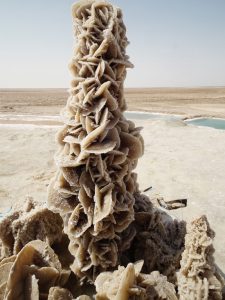
COURTESY TO WIKIMEDIA COMMONS
Desert roses form in desert environments where saline playas evaporate, precipitating gypsum, which crystallizes within the wet sand. Barite [barium sulfate, BaSO 4 ] and celestine [strontium sulfate, SrSO 4 ] also form desert roses, but gypsum roses have sharper blades and more intricate structures. Desert flowers, a modified type of desert rose, are columnar clusters of gypsum crystals that rise several feet above the desert floor.
Commercial collecting of gypsum desert roses is a local industry along the northern rim of the Sahara Desert, notably at Chott el Djerid, a closed saline basin on the Tunisia-Algeria border. Gathered literally by the ton, these roses are sold regionally to tourists or shipped to rock shops and novelty shops in Europe and North America. Small gypsum desert roses cost only a few dollars, while large, well-developed, intricate specimens sell for hundreds of dollars each.
Gypsum in Caves
Gypsum also occurs as speleothems, secondary deposits that form within caves by precipitation from flowing, dripping, ponded or seeping water. While most speleothems (the word comes from the Greek words spelaion, or “cave,” and théma, meaning “deposit”) are calcite, some are gypsum.
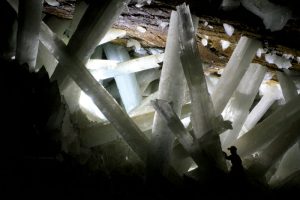
The largest-known gypsum stalactites are found in Lechuguilla Cave (no public access) in New Mexico’s Carlsbad Caverns National Park.
White, 20-foot-long stalactitic sheets of gypsum called chandeliers hang from cave ceilings, their tips adorned with delicate, radiating sprays of colorless selenite crystals.
At Kentucky’s Mammoth Cave National Park, gypsum occurs as cave flowers, curving rosettes made of long, hair-like selenite crystals that grow on horizontal surfaces.
Sharply curved, free-standing ram’s horns are modified cave flowers.
The world’s largest natural gypsum caves can be seen at Alabaster Caverns State Park near Freedom, Oklahoma, where the host rock is a massive formation of white-to-pinkish alabaster. The walls of the main gallery, 60-feet high and three-quarters of a mile long, are dotted with pockets of small selenite crystals and occasionally laced with veins of rare, black alabaster that is colored by inclusions of organic carbon.
The only other known occurrences of black alabaster are in China and Italy.
Hydrogen Bonding
Gypsum is a hydrous mineral containing molecules of water called “water of hydration” that are attached by very weak hydrogen bonding. This is established when the positive poles of water molecules are attracted to the slight negative charge of the oxygen atoms in the sulfate anions. Within the gypsum lattice, calcium-sulfate layers sandwich the water-molecule layers.
The weak hydrogen bonding along the plane of the water layer explains the gypsum’s perfect one-directional cleavage, softness, and thin-crystal flexibility.
Because hydrogen bonding is strongest at cold temperatures, gypsum is unstable when heated. Heat separates its hydrogen bonds and drives off most of the water of hydration. Sub-fusing temperatures produce calcined gypsum or plaster, a hemihydrated powder with the formula CaSO 4·½H O. Further heating converts this hemihydrate into anhydrous calcium sulfate (CaSO 4 ).
The structures of calcined gypsum and natural gypsum are identical, except the lattice sites in calcined gypsum previously occupied by water of hydration are vacant. When water contacts calcined gypsum, it immediately reoccupies these vacant sites, reestablishing both the hydrogen bonds and the rigid structure of natural gypsum. This ability to quickly lose and regain water of hydration is the key to some of gypsum’s most important uses, especially as plaster.
Gypsum Plaster
Crude gypsum plaster appeared in Anatolia (present-day Turkey) around 6000 BCE.
By 3700 BCE, the Egyptians were using it as interior-wall coverings and as a mortar-binding agent in their pyramids. The ancient Greeks and Romans created mixtures of gypsum and marble dust called stucco for use as plaster and a sculpting and casting medium.

In European Renaissance art, gypsum-based plaster was the substrate for fresco paintings. Angelic figures made of white stucco adorned churches, while architectural stucco friezes decorated plazas, gardens and pavilions. Stuccowork reached its peak of popularity during the 17th and 18th centuries when polychrome stucco figures were standard décor for baroque and rococo palaces.
By the late 1700s, additives had greatly improved the workability of quick-setting gypsum plaster by retarding its setting time. Gypsum plaster, called Plaster of Paris after the huge gypsum beds in France’s Paris Basin, had become Europe’s standard wall covering.
After chemists found that gypsum was a valuable agricultural soil nutrient, it was much in demand by farmers as the world’s first chemical fertilizer.
By the early 1800s, the United States still had no domestic gypsum sources, while Canada’s maritime colonies had many. A brisk smuggling trade developed between New Brunswick, Canada and Maine. When Canadian authorities began seizing US-bound gypsum shipments, Canadian miners and smugglers staged a violent revolt.
Canadian officials finally backed down, allowing the illegal trade to continue and ending what became known as the Plaster War of 1820.
Gypsum as an Industrial Material
Gypsum’s emergence as a major industrial mineral began in 1888 when American inventor, Augustine Sackett, poured a half-inch-thick layer of Plaster of Paris on a sheet of manila paper and covered it with a second sheet. The plaster hardened into rigid panels of what was called “Sackett board.” Cheap, durable, non-flammable and an excellent thermal insulator, the Sackett board quickly replaced traditional wooden and lath-and-plaster walls. It revolutionized the global construction industry and is known today as wallboard or drywall.
About 155 million tonnes of gypsum are now mined globally each year in a multi-billion-dollar-per-year industry. The US leads the world in production, annually mining 21 million tonnes of gypsum from 50 mines in 17 states. Gypsum ore, an impure form of gypsum called gypsite or gypsum rock, is obtained from both open-pit and underground mines. It is crushed, hydraulically concentrated, and calcined into calcium-sulfate hemihydrate, the feedstock for the manufacture of Plaster of Paris and wallboard.
The United States now produces 28 billion square feet of wallboard each year—enough to cover the entire state of Rhode Island. The wallboard in today’s average new house contains seven tonnes of gypsum.
Gypsum is also used in casts for dental plates, metal parts and surgical splints. Granulated gypsum is a standard conditioner for alkaline soils. Powdered gypsum is used as the preferred bedding material for polishing plate glass, as a filler for paints and papers, a flux for reduction smelting, and the setting retardant that enables portland cement to be premixed and transported. Blackboard and sidewalk chalks are not chalks at all, but powdered gypsum.
The flue-gas-desulfurization systems that reduce sulfur-dioxide [(SO 2 ] emissions from coal-fired power plants yield huge quantities of synthetic gypsum. Despite this supply and the large-scale mining of gypsum rock, the US must still import gypsum to meet domestic demand. Crude gypsum currently sells for $7 per tonne, and calcined gypsum for $20 per tonne.
Gypsum Sand
Because of its solubility in water, gypsum sand is rare, but it’s few occurrences are noteworthy. Southern New Mexico’s White Sands National Park includes half of a 275-square-mile dune field of pure gypsum sand. With an average depth of 30 feet and dunes as high as 60 feet, the dune field contains an estimated 4.1 billion tonnes of gypsum—enough to theoretically satisfy the world’s wallboard demand for the next 500 years.
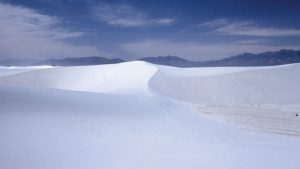
The origin of the White Sands dunes goes back 250 million years to a Permian sea that precipitated thick layers of gypsum-rich sediments. After lithifying into a 1,600-foot-thick gypsum-rock formation, these sediments were tectonically uplifted thousands of feet to form part of today’s San Andres Mountains. Crustal subsidence to the east then created the Tularosa Basin, a closed depression with no outlet.
Over millions of years, gypsum-rich sediments washed down from the San Andres Mountains into the Tularosa Basin. When the last Ice Age ended in a much wetter climate, the Tularosa Basin was a shallow, gypsum-rich lake where seasonal, filling-and-evaporation cycles deposited thick layers of gypsum. Then, as the climate became drier, this lake became a vast flat covered with crusts of selenite crystals. Continuous cycles of freezing, thawing and drying eventually reduced these crystals to particles of fine sand which, because of their low density, were carried by prevailing westerly winds and deposited in today’s huge While Sands dune field.
When strong demand drove gypsum prices upward in the 1920s, White Sands attracted a horde of speculators and miners. With the dunes legally classified as a placer deposit, would-be miners staked hundreds of 20-acre placer claims that collectively covered 10 square miles.
But because of White Sands’ remoteness, high shipping costs made mining uneconomical. By 1930, the scenic value of While Sands became apparent with the rapid growth of western automobile tourism. In January 1933, President Herbert Hoover put an end to any future hopes of mining White Sands by declaring it a national monument. Today, the gleaming gypsum dunes of what is now White Sands National Park attract more than 600,000 visitors annually.
This story about gypsum previously appeared in Rock & Gem magazine. Click here to subscribe. Story by Steve Voynick.



